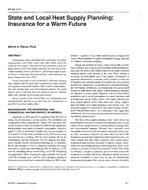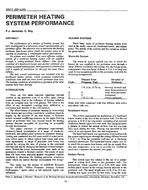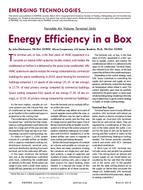-
-
Available Formats
- Options
- Availability
- Priced From ( in USD )
-
Available Formats
-
- Immediate download
-
$16.00Members pay $7.00
- Add to Cart
Customers Who Bought This Also Bought
-

AT-96-11-4 -- State and Local Heat Supply Planning: Insur...
Priced From $16.00 -

3507 (RP-426) -- Perimeter Heating System Performance
Priced From $16.00 -

RP-862 -- Development of a Methodology to Design and Pred...
Priced From $32.00 -

Emerging Technologies: Variable Air Volume Terminal Units...
Priced From $9.00
About This Item
Full Description
Variable Refrigerant Flow (VRF) heat pumps are gaining more recognition as a highly efficient system for heating and cooling applications. These are advanced heat pump systems with the option of heating and cooling/dehumidification simultaneously as well as recovering heat, called VRF 3-pipe systems. Zoning with individual control and minimal or no ductwork are the main advantages of these systems which could be an ideal choice for multi-zone commercial buildings. The system consists of a single outdoor unit and multiple indoor units for each zone plus refrigerant piping and branch selector boxes. The all-electric systems have been around for more than two decades in North America and are being offered by some manufacturers.
This study is conducted to monitor and evaluate the performance of a GEHP VRF system installed at a farm market located in Cobourg, Ontario - the first install in the Canadian climate. The system is comprised of a 14-ton outdoor unit and eleven indoor units installed in four main zones in the bakery and retail area with a total area of 720m2 [7,642ft2].
The system was commissioned in February 2020 almost at the end of the peak heating season. The system was in the heating mode until mid-May 2020 and switched to the cooling mode thereafter. During March, the system was always working in part load (30% to 40% capacity), primarly due to mild weather with an average outdoor temperature of 2°C [36°F]. Another contributing factor was that the system was oversized to allow for future building load increase. In this month the measured input and output energy ratio (COP) was 1.38 which exceeded the rated unit COP of 1.3. This confirms the characteristic of the VRF system that could maintain its high-efficiency performance in the part load. In this month, the total natural-gas consumption was 970m3 [350 therms]. In the peak cooling season, in the month of July, the system was also working in part load (50% to 60% capacity) with an average outdoor temperature of 26°C [79°F]. The system COP was 1.47 which is almost in line with the unit rated COP. The Natural-gas consumption for this month was 1,112m3 [400 therms].





